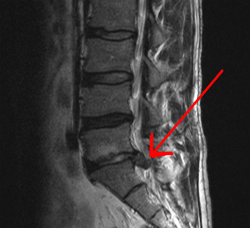Herniated Disk
- Details
- Published: 27 February 2015
- Hits: 5215
The bones of your spinal column (vertebrae) protect your spinal cord and nerves that go into your arms and legs. The vertebrae are separated by disks that cushion the spinal column and put space between your vertebrae. This allows movement between the vertebrae, which allows you to bend, rotate, and move your body from side to side.

Sometimes, the disks move out of place (herniate) or break open (rupture) from injury or strain. The most common area for a disk herniation is in the lower back (lumbar area). Sometimes herniation occurs in the neck (cervical) disks.
CAUSES
As we grow older, the strong, fibrous cords that connect the vertebrae and support and surround the disks (ligaments) start to weaken. A strain on the back may cause a break in the disk ligaments.
RISK FACTORS
Herniated disks occur most often in men who are aged 18 years to 35 years, usually after strenuous activity. Other risk factors include conditions present at birth (congenital) that affect the size of the lumbar spinal canal. Additionally, a narrowing of the areas where the nerves exit the spinal canal can occur as you age.
SYMPTOMS
Symptoms of a herniated disk vary. You may have weakness in certain muscles. This weakness can include difficulty lifting your leg or arm, difficulty standing on your toes on one side, or difficulty squeezing tightly with one of your hands. You may have numbness. You may feel a mild tingling, dull ache, or a burning or pulsating pain.
In some cases, the pain is severe enough that you are unable to move. The pain most often occurs on one side of the body. The pain often starts slowly. It may get worse:
• After you sit or stand.
• At night.
• When you sneeze, cough, or laugh.
• When you bend backwards or walk more than a few yards.
The pain, numbness, or weakness will often go away or improve a lot over a period of weeks to months.
Herniated lumbar disk
Symptoms of a herniated lumbar disk may include sharp pain in one part of your leg, hip, or buttocks and numbness in other parts. You also may feel pain or numbness on the back of your calf or the top or sole of your foot. The same leg also may feel weak.
Herniated cervical disk
Symptoms of a herniated cervical disk may include pain when you move your neck, deep pain near or over your shoulder blade, or pain that moves to your upper arm, forearm, or fingers.
DIAGNOSIS
To diagnose a herniated disk, your caregiver will perform a physical exam. Your caregiver also may perform diagnostic tests to see your disk or to test the reaction of your muscles and the function of your nerves.
During the physical exam, your caregiver may ask you to:
• Sit, stand, and walk. While you walk, your caregiver may ask you to try walking on your toes and then your heels.
• Bend forward, backward, and sideways.
• Raise your shoulders, elbow, wrist, and fingers and check your strength during these tasks.
Your caregiver will check for:
• Numbness or loss of feeling.
• Muscle reflexes, which may be slower or missing.
• Muscle strength, which may be weaker.
• Posture or the way your spine curves.
Diagnostic tests that may be done include:
• A spinal X-ray exam to rule out other causes of back pain.
• Magnetic resonance imaging (MRI) or computed tomography (CT) scan, which will show if the herniated disk is pressing on your spinal canal.
• Electromyography. This is sometimes used to identify the specific area of nerve involvement.
TREATMENT
Initial treatment for a herniated disk is a short period of rest with medicines for pain. Pain medicines can include nonsteroidal anti-inflammatory medicines (NSAIDs), muscle relaxants for back spasms, and (rarely) narcotic pain medicine for severe pain that does not respond to NSAID use. Bed rest is often limited to 1 or 2 days at the most because prolonged rest can delay recovery. When the herniation involves the lower back, sitting should be avoided as much as possible because sitting increases pressure on the ruptured disk. Sometimes a soft neck collar will be prescribed for a few days to weeks to help support your neck in the case of a cervical herniation.
Physical therapy is often prescribed for patients with disk disease. Physical therapists will teach you how to properly lift, dress, walk, and perform other activities. They will work on strengthening the muscles that help support your spine.
In some cases, physical therapy alone is not enough to treat a herniated disk. Steroid injections along the involved nerve root may be needed to help control pain. The steroid is injected in the area of the herniated disk and helps by reducing swelling around the disk. Sometimes surgery is the best option to treat a herniated disk.
SEEK IMMEDIATE MEDICAL CARE IF:
• You have numbness, tingling, weakness, or problems with the use of your arms or legs.
• You have severe headaches that are not relieved with the use of medicines.
• You notice a change in your bowel or bladder control.
• You have increasing pain in any areas of your body.
• You experience shortness of breath, dizziness, or fainting.
MAKE SURE YOU:
• Understand these instructions.
• Will watch your condition.
• Will get help right away if you are not doing well or get worse.
